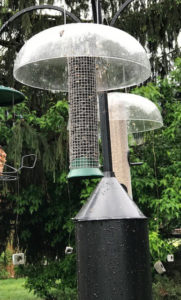How to Get Rid of Black Capped Chickadees
Keeping House Sparrows away from feeders
February 13, 2020

House Sparrows by Bonnie Coe
A FeederWatcher shares his strategies
An invasion of House Sparrows almost caused FeederWatcher Bill Kampen in Leavenworth, Washington, to stop feeding birds. A few sparrows appeared at Bill's feeders one day, and soon there were so many House Sparrows that they crowded out other species. It can be difficult to prevent House Sparrows from dominating a backyard. Bill tried many strategies, like spreading bark butter (a soft suet) on the underside of tree limbs, hoping House Sparrows wouldn't attempt to reach such an inaccessible food source. Bill told us that the sparrows "hovered in place like hummingbirds," to get at the bark butter. "You have to admire their tenacity and ingenuity." After some trial and error, Bill found a few effective strategies, shared below.
If you've tried everything, consider taking down feeders for a couple of weeks. Then build back the feeding operation one feeder at a time. And if you have nest boxes that House Sparrows are using, swap them for wren or chickadee boxes, which have smaller entrance holes. Because House Sparrows are not native, it is legal to remove them. Given their invasive nature, reducing their populations may in some cases help native bird populations, but this option isn't for everyone. Individuals who would like to take an active role in reducing House Sparrow populations can find information on the NestWatch website.
Although there is evidence that House Sparrows out compete native birds for nest cavities, it's unclear if feeding them harms native bird populations. Nevertheless, we know that many people would rather not feed House Sparrows, and we hope that these suggestions will help them attract a wider variety of birds to their feeders.
Tips for feeding birds without feeding House Sparrows
Provide suet without embedded seeds.
Most suet-eating birds, like woodpeckers, jays, chickadees, and nuthatches, are more interested in the suet than the seeds. House Sparrows, however, favor the seeds. If you choose to use suet with embedded seeds, "upside-down feeders" that only allow access from the bottom will discourage most House Sparrows. After switching to this type of suet feeder, Bill reported, "I did see one House Sparrow clinging to it, but sparrows are just not built for hanging upside down, so the sparrow dropped off in a few seconds and has not returned."
Try preformed seed shapes.

House Sparrows don't seem to like seeds provided in hard, preformed shapes, such as cylinders or bells. Perhaps the seeds are too difficult to remove. If you use a seed cylinder, place an old CD disc on top to prevent larger birds from perching near the top and pecking down, forcing the cylinder to break apart.
Use nyjer-seed feeders to attract finches.
Small finches like American Goldfinches, Common Redpolls, and Pine Siskins will come to nyjer-seed feeders that have perches and ports too small for House Sparrows. House Sparrows may perch and attempt to feed, but their larger bodies and bills make it awkward. Crushed sunflower chips can sometimes be provided in these feeders to attract a few more small species, such as chickadees, but the chips may clump and block the ports in cold, damp conditions.
Protect sunflower seed feeders with a halo baffle.


University of Nebraska researchers discovered that the hanging wires used to keep gulls away from landfills and reservoirs could be used to deter House Sparrows without bothering other species. You can construct your own halo using a dome squirrel baffle/weather shield. Drill two holes on opposite sides from each other near the bottom of the baffle. Attach one end of a strand of wire through each hole, and attach a small weight to the other end of each wire. Two more strands can be added if needed by drilling holes halfway between the first holes. Find more information plus suggestions from participants on our blog. And read about a halo baffle variation in the deterring unwanted visitors section of our Tips from FeederWatchers web page.
Avoid millet, cracked corn, and all ground feeding.
House Sparrows favor millet, especially when it's on the ground. If you want to continue providing food for ground-feeding birds such as quail, doves, and native sparrows, limit the feeding to small amounts at a time to help reduce the number of House Sparrows
<< Return to blog home
How to Get Rid of Black Capped Chickadees
Source: https://feederwatch.org/blog/keeping-house-sparrows-away-from-feeders/